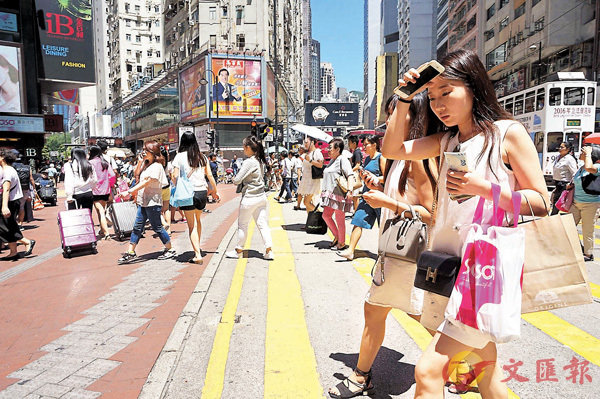 ���M�a��ij�N���������f�o���Ϋؿv���ѥx��զ�A���U�V�w�u���q�����v�C ��ƹϤ�
���M�a��ij�N���������f�o���Ϋؿv���ѥx��զ�A���U�V�w�u���q�����v�C ��ƹϤ��i���j�U��K���ۭ���m��׳��n2017�~6��5����D�G
��Ǯa���e�b�m�۵M����ܤơn�]Nature Climate Change�^���Z�Z�X�פ�A���X�����u���q�����v�]heat island effect�^�v�T���j�����]megacity�^�A�N�O����ܤƥD�n���`�̡]victim�^�A�����H�f�̦h���@�峣���A������Ũ쥻�@�����N�W��7�J�ƦܧA�����v�T�����_�~�A�P�ɺc���e�j�g�ٷl���]economic loss�^�C
�M�a��ij�N�D���Ϋؿv���ѥx��զ�A�î�ا�h�Ӫ��A��ĭ��C��šC
�}�Žե[�@ �g�ٷl���j
�}�o�����]urbanization�^�ɤ��K�n��y�۵M���ҡ]natural landscape�^�A�Ҧp��h���]vegetation�^�A��������A�ÿ��ؤj�q�f�o���]asphalt pavement�^�Ϋؿv���A���̧��|�l������]heat-trapping�^�C��s�o�{�A�Y�����ŬO38�J�A�ؿv�����¦�ѥx�鶡��ťi�ɦ�88�J�C
���~�A�T���ΧN��t�Χ��|�ƥX����]waste heat�^�C�]���A�j������ũ������������A�o�ز{�H�Q�٬��u���q�����v�C
�����~���ݭn�Žա]air-conditioning�^�O���D�֡A�o���F�[�@�u���q�����v�A��O��ݨD�]energy consumption�^�W�ɡC�M�a���X�A��Էx�Ʒ|�ۭP�g�ٷl���A�H���v�T���Y�����������ҡA�ֿn�l����2100�~�N�����a�Ͳ��`��10.9%�C
�f�o�����զ� �i��2�J
�����̪��f�o�����M�O�l�����¦�A�M�a��ij�N���̤Ϋؿv���ѥx��զ�A�S�Ψ�L���ĤϮg�]reflect�^���O���L��A�üW�[�Ӿ�A���U�V�w�u���q�����v�C
�H�^��۴��]London�^���ҡA������Ÿ���������4�J�A�p�G���F�������įǤW�z���I�A�h���U�N��ŭ��C2�J�C�N��u��ˡ]transform�^20%�D���Ϋؿv���A�]�୰�C���0.8�J�C�����ӻ��A���I���٤U�۵���12���������}��C
�ѻP���g�פ媺�^���Ķ�J���p�j�ǡ]University of Sussex�^�б¦����]Richard Tol�^�١A�U�ɦV�Ӷ����b���y�h����ܡ]tackle�^����ܤơA�����F�a�ϩʪ��ܤơC�M�a�١A�W�z���I�參���ͬ����ͧ����U�A���L�L�U������y�x�ơ]global warming�^�A�u���v�T�C
�L�������M�a���X�A���y�x�ƹ�H�N��ԫ����������v�T�A�]���a�~���i�`�ٷx��A���ѻP���g�פ媺�J���S�ԹF�]Francisco Estrada�^���X�A�o���u�ա]advantage�^�|�H�Ӯ�Ť��_�k�ɦӮ����C
"Heat island" makes cities hotter as century closes
�iĶ��jA group of scientists have published an analysis in the journal Nature Climate Change recently, saying that big cities suffered from "heat island effect" would be the major victims of climate change, in which megacities with high population density would become warmer by 7�J or more by the end of this century, bringing about negative impacts on the urban life of city dwellers and great economic losses.
The professionals suggested taking measures such as painting the roads and roofs white, having widespread tree-planting and the like to reduce urban warming.
Air-con amplifies heating effect
Urbanization would inevitably lead to the change of natural landscape, such as replacing vegetation and water by the heat-trapping asphalt pavements and concrete buildings.
It was found that temperatures of black rooftops can reach as high as 88�J if the temperature is 38�J. Waste heat from vehicles and air-conditioners would also push up air temperatures.
Therefore, temperatures in urban areas are often much higher than that in rural areas, resulting in the heat island effect.
Moreover, the use of air-conditioning for cooling intensifies the effect and also increases energy consumption. It was predicted that global warming would bring about economic costs and the total cumulative losses of the worst-off city could even reach 10.9% of GDP by 2100.
White asphalt would dispel heat
The black asphalt pavements in cities are often heat-absorbing. The experts suggested painting them and the roofs in white or other lighter colors that can reflect heat, as well as expanding vegetation to reduce the heat island effect.
Taking London as an example, downtown temperatures are usually 4�J higher. But if the government implements all of the above-mentioned measures, temperatures would decrease by 2�J. Even by transforming just 20% of the city's pavements and buildings into less heat-trapping forms can reduce the air temperatures by about 0.8�J and save up to 12 times the costs for installation and maintenance in the long run.
The co-author Richard Tol, a professor at the University of Sussex, said that much emphasis was put on tackling global climate change but the importance of local interventions was underestimated.
The professionals believed that the aforementioned local measures, albeit not being helpful in reducing global warming, would greatly benefit our daily life and eliminate some of the negative impacts, to a certain extent.
Some previous studies have suggested that cities in colder climates might benefit from global warming because of lower winter heating costs. But the lead author Francisco Estrada argued that such advantage would probably disappear as temperatures keep rising.���e�Ż�
Q&A
1. ��������y�x�ơA�@�ɦU���2015�~�p�X���Ԯp�|�]2015 United Nations Climate Change Conference�^��ñ�q�F�����ij�H
2. �ӤW�D�A�Ө�ij����y��ŭq�ߤF����ؼСH
3. �Ө�ij�Ѧh�֭Ӱ�a�@�Pñ�q�H
4. �Ө�ij���N�F�H�e������ij�ѡH
5. �̪���Ӱ�a�ŧG�N�h�X�Ө�ij�H
1.�m�ھ���w�n�]Paris Agreement�^
2. ����y������ŤɴT����b�u�~���R�e�����H�W�C��2�J�H��
3. 195��
4. �m�ʳ�ij�w�ѡn�]Kyoto Protocol�^
5. ����

